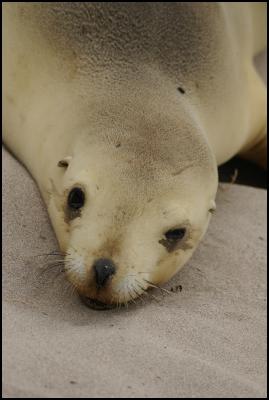Research reveals New Zealand sea lion is a relative newcomer

NZ Sea Lion. Photo: Louise Chilvers
Research reveals
New Zealand sea lion is a relative
newcomer
Embargoed until 11am Wednesday
14 May 2014
The modern New Zealand sea lion is a relative newcomer to our mainland, replacing a now-extinct, unique prehistoric New Zealand sea-lion that once lived here, according to a new study led by University of Otago researchers.
A team of biologists from the University of Otago estimates that this prehistoric mainland sea-lion population became extinct as recently as 600 years ago, and was then replaced by a lineage previously limited to the waters of the cold subantarctic.
The Marsden-funded study, carried out by Otago Zoology PhD student Catherine Collins, and led by Professor Jon Waters, set out to investigate changes in the New Zealand sea-lion population since human settlement.
Ms Collins says they were startled to identify a previously unknown sea-lion lineage that dominated South Island shores until just a few hundred years ago.
“It is
estimated that the mainland sea-lions became extinct between
1300 and
1500AD, soon after Polynesian settlement, and
midden remains suggest they were hunted extensively. The
extinction apparently created an opportunity for the
subantarctic lineage to colonise New Zealand’s mainland,"
she says.
The team identified the extinct mainland sea-lion lineage using ancient DNA from prehistoric bones.
“We found that the extinct mainland population was clearly genetically distinct from the modern subantarctic population that arrived more recently,” she says.
The unexpected finding closely mirrors a prehistoric extinction-replacement event for yellow-eyed penguins, recently detected by the same team led by Professor Waters.
“Our findings demonstrate that our current sea-lion population is not a declining remnant of an original mainland population, but rather represents a new arrival from the subantarctic,” he says.
“Competition between the two lineages may have previously prevented the subantarctic lineage from expanding northwards to the mainland of New Zealand."
Professor Waters adds that all they know for certain about the attributes of this prehistoric sea-lion is that it was genetically distinct from the modern sea-lion lineage. He anticipates that future study of the prehistoric remains will lead to a greater understanding of its biology.
The team’s findings have
been published today in the international
biological
research journal Proceedings of the Royal
Society B: Biological
Sciences.
ENDS


 Science Media Centre: Cyclone Gabrielle's Impacts On NZ's Ecosystems - Expert Reaction
Science Media Centre: Cyclone Gabrielle's Impacts On NZ's Ecosystems - Expert Reaction RNZ: Parts Of Power System Could Be Out For 36 Hours In Event Of Extreme Solar Storm
RNZ: Parts Of Power System Could Be Out For 36 Hours In Event Of Extreme Solar Storm NZAS: New Zealand Association Of Scientists Awards Celebrate The Achievements Of Scientists And Our Science System
NZAS: New Zealand Association Of Scientists Awards Celebrate The Achievements Of Scientists And Our Science System Stats NZ: Retail Spending Flat In The September 2024 Quarter
Stats NZ: Retail Spending Flat In The September 2024 Quarter Antarctica New Zealand: International Team Launch Second Attempt To Drill Deep For Antarctic Climate Clues
Antarctica New Zealand: International Team Launch Second Attempt To Drill Deep For Antarctic Climate Clues Vegetables New Zealand: Asparagus Season In Full Flight: Get It While You Still Can
Vegetables New Zealand: Asparagus Season In Full Flight: Get It While You Still Can 



